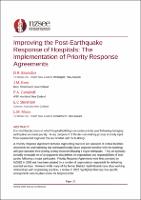Improving the Post-Earthquake Response of Hospitals: The Implementation of Priority Response Agreements

Download
Date
2024-04-09Authors
Brunsdon, Dave
Keen, Jared
Campbell, Paul
Stevenson, Craig
Moon, Lisa
Metadata
Show full item recordAbstract
It is vital that decisions on which hospital buildings can continue to be used following damaging earthquakes are made quickly. A key component of the decision-making process is timely input from experienced engineers that are familiar with the buildings.
A Priority Response Agreement between engineering practices and operators of key facilities documents the understanding that nominated locally-based engineers familiar with the buildings will give operators their priority as they respond following a major earthquake. They are typically annually renewable set of arrangements that defines the expectations and responsibilities of both parties following a major earthquake. Priority Response Agreements were first promoted by NZSEE in 2005 and have been adopted by a number of organisations responsible for delivering essential services. However while many of the former District Health Boards have close working relationships with engineering practices, a review in 2022 highlighted that very few specific arrangements were in place across the hospital sector.
After the establishment of Te Whatu Ora – Health New Zealand in 2022, the new national agency established a Seismic Work Programme to address identified gaps and issues. One of the first priorities of this programme was to create Priority Response Agreements for all major hospitals. This paper provides the background to Priority Response Agreements generally, and outlines the process by which they are being put in place for New Zealand hospitals. Linkages with seismic instrumentation and MBIE’s wider Rapid Building Assessment programme are also highlighted.
